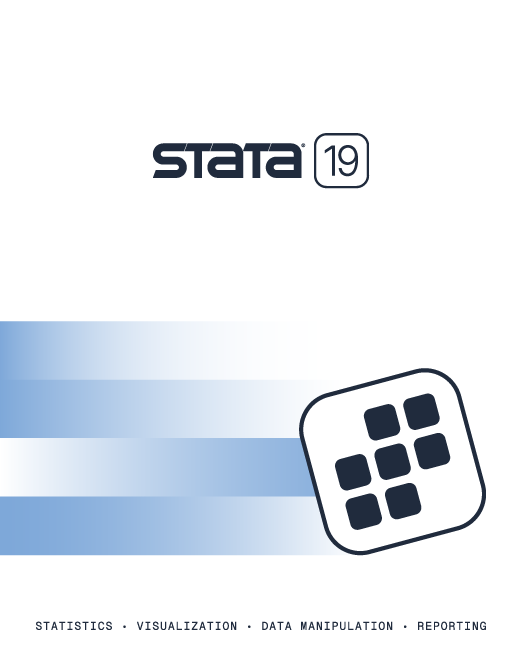
| Title | Stata 6: Estimating fixed-effects regression with instrumental variables | |
| Author |
Vince Wiggins, StataCorp William Gould, StataCorp |
Is anyone aware of a routine in Stata to estimate instrumental variable regression for the fixed-effects model? I cannot see that it is possible to do it directly in Stata.
If we don’t have too many fixed-effects, that is to say the total number of fixed-effects and other covariates is less than Stata's maximum matrix size of 800, and then we can just use indicator variables for the fixed effects. This approach is simple, direct, and always right.
For example, using the auto dataset and rep78 as the panel variable (with missing values dropped) we could estimate a fixed-effects model of mpg on weight and displacement. Let's assume displacement is endogenous and we have gear_ratio and headroom as instruments.
First, generate indicator variables named dr1-dr5, then use ivreg to perform the estimation.
. tab rep78, gen(dr) (output omitted) . ivreg mpg weight dr* (displ = gear_ratio headroom) Instrumental variables (2SLS) regression
| Source | SS df MS | Number of obs = 69 | F(6, 62) = 20.25 |
| Model | 1536.20001 6 256.033334 | Prob > F = 0.0000 | |
| Residual | 804.002893 62 12.9677886 | R-squared = 0.6564 | Adj R-squared = 0.6232 |
| Total | 2340.2029 68 34.4147485 | Root MSE = 3.6011 |
| mpg | Coefficient Std. err. t P>|t| [95% conf. interval] | |
| displacement | -.0158046 .0281621 -0.56 0.577 -.0720999 .0404907 | |
| weight | -.0038296 .0030457 -1.26 0.213 -.0099178 .0022587 | |
| dr1 | .093266 2.932757 0.03 0.975 -5.769231 5.955763 | |
| dr2 | (dropped) | |
| dr3 | -.094414 1.444669 -0.07 0.948 -2.982265 2.793437 | |
| dr4 | -.3131534 1.596628 -0.20 0.845 -3.504767 2.878461 | |
| dr5 | 2.217366 1.895149 1.17 0.246 -1.570984 6.005716 | |
| _cons | 35.79702 4.005494 8.94 0.000 27.79015 43.80389 | |
In real examples, you will probably have to increase matsize before estimating the model. You will see
. ivreg ... matsize too small; type -help matsize- r(908)
You can set matsize to any number up to 800, assuming you have sufficient memory:
. set matsize 800
What if we have too many panels to estimate the model directly? In that case, xtdata can be used to transform the data to mean differences, and ivreg can then be used to estimate the fixed-effects model on the transformed data; thus you will not have to reset matsize at all.
We can estimate the same model as above by typing
. drop if rep78==. (5 observations deleted) . xtdata mpg weight displ gear_ratio headroom, i(rep78) fe clear . ivreg mpg weight (displ = gear_ratio headroom) Instrumental variables (2SLS) regression
| Source | SS df MS | Number of obs = 69 | F(6, 62) = 20.25 |
| Model | 986.784228 2 493.392114 | Prob > F = 0.0000 | |
| Residual | 804.002893 66 12.181862 | R-squared = 0.5510 | Adj R-squared = 0.5374 |
| Total | 1790.78712 68 26.3351047 | Root MSE = 3.4903 |
| mpg | Coefficient Std. err. t P>|t| [95% conf. interval] | |
| displacement | -.0158046 .0272954 -0.58 0.565 -.0703016 .0386924 | |
| weight | -.0038296 .002952 -1.30 0.199 -.0097233 .0020642 | |
| _cons | 36.03048 3.843726 9.37 0.000 28.35623 43.70472 | |
| Solution 1 | Solution 2 | |
| mpg | Coef. Std. Err. | Coef. Std. Err. |
| displ | -.0158046 .0281621 | -.0158046 .0272954 |
| weight | -.0038296 .0030457 | -.0038296 .002952 |
| _cons | 35.79702 4.005494 | 36.03048 3.843726 |
Comparing the estimates, we observe
The standard errors (SEs) differ by a scale factor and that is easily fixed. The intercept differs because of an unimportant difference in interpretation.
The SEs differ by a scale factor because our estimate of the residual variance, RMSE, also differs between the solutions. In Solution 2, the SEs are not adjusted for the fact that we estimated the fixed effects. We can adjust them:
SE(soln. 1) = SE(soln. 2) * sqrt( e(dfr) / (e(dfr)-M+1) )
where M is the number of panels and M=5 in this case. For instance, the standard error for _b[displ] can be obtained by typing
. display _se[displ] * sqrt(e(dfr)/(e(dfr)-5+1)) .02816214
You do not have to adjust the standard errors—the reported SEs are asymptotically equivalent. Solution 1’s SEs have been adjusted for finite samples, and many researchers prefer that the adjustment be made. With reasonable sample sizes, however, the adjustment will not amount to much.
The intercept differs because of difference in interpretation.
In Solution 1, we did not take any care in computing the intercept and let the indicator for rep78==2 drop out of the equation. Thus the intercept in that equation is the intercept for the case rep78==2.
In Solution 2, xtdata mean-differenced the data and then added back in the overall mean. Thus the reported intercept is essentially the overall intercept for all the data; see the FAQ at stata.com/support/faqs/statistics/intercept-in-fixed-effects-model for a discussion.
Both solutions are equivalent.